Under Brazilian Skies
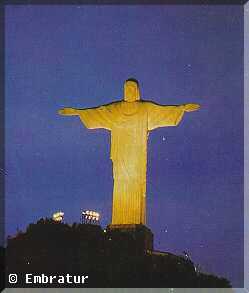
Christ the Redeemer-Rio de Janeiro
Courtesy of Embratur
©1997
Under Brazilian Skies

Christ the Redeemer-Rio de Janeiro
Courtesy of Embratur
©1997
| Bemvindo a Brasil. Welcome to my page about Brasil. It is a beautiful, resource rich country in the heart of South America. It is large, actually the only countries in South America it does not border are Ecuador and Chile. There is a special warmth about the Brazilians, a passion in their approach to life. |
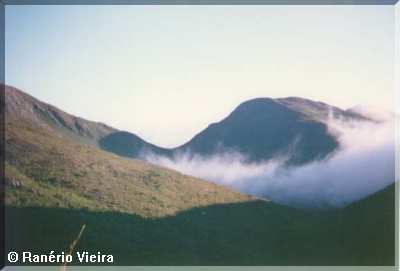
| When one thinks of Brasil the first things to
come to mind for most are Carnaval and the Amazon and the beaches of
Rio,
but there is much more. It is a beautiful land of gorgeous
sunsets, mountain ranges and waterfalls as well as a long coastline on the Atlantic. It is a land of many rhythms... European, native, African.
The culture, music, art, religion and food all show unmistakable influences of each of these. It is a land of bright colors and contrasts. There is the modernity of
Brasilia, the capital, with its glass buildings and modern architecture,
and the classical beauty of Ouro Preto and the wilderness of the Amazon.
Brasil takes up the major portion of the South American landmass, however, unlike most of its neighbors, Brasil was settled by the Portuguese rather than the Spaniards. The cultural heritage is similar in some ways, very different in others. One obvious difference is the language. Brasil is the largest portuguese speaking nation on earth. Some compare the difference between Brasilian portuguese and portuguese from Portugal to be something like the difference between the english spoken in the U.S. and Britain. Portuguese and Spanish are, of course, very similar, having both originated in the Iberian Peninsula. It is not too difficult to understand for many spanish speaking people. Brasil's population combines the descendants of European settlers, the native populations and the African slaves. Brasilians tend to note with great pride how diverse Brasil is and how much earlier it took steps toward becoming a multi-racial society. |
| The Carnaval in Rio, one of the best parties in the world, is a lot like the Mardi Gras in New Orleans. Unlike the Mardi Gras, Carnaval has a far deeper influence of Brazil's African population, particularly in its music. Its religious roots are similar, occurring around Lent, and the traditions of parades and floats are also European in origin. |
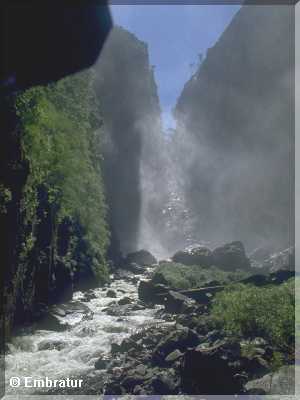
| Brazil, and the Amazon in particular, has some
of the most pristine wilderness anywhere, with
a rich variety of plant and animal life. Like all
nations it is struggling to create economic
development. A major concern has to be the
preservation of the environment. One study
found that 303 endangered species and sub
species live in Brasil.
Another major concern has been the native population. At the time of colonization there were about 5 million, while there are now less than half a million. There are some 200 distinct groups of natives that speak 180 different languages. Some tribes have integrated totally into contemporary society, while others, primarily in the Amazon, still live almost totally cut off from the world around them. |
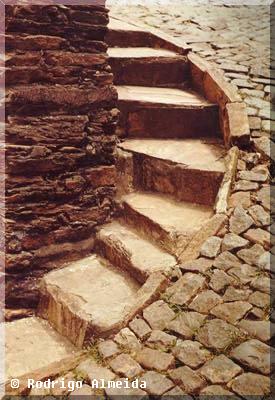
Meia Volta - Ouro Preto - Minas Gerais
© by Rodrigo Almeida
| There is the classical architecture of cathedrals all over Brasil, a deeply Catholic country. Rio de Janeiro is the largest Catholic archdiocese in the world. Because of this, the Archbishop of Rio, Dom Paulo as he is affectionately known by Brazilians, plays an important role in the Catholic Church and has been influential in calling for greater social justice. He was a major force in making the church less euro-centric and more responsive to the non-spiritual needs of its flock. As in many other places, the Church has often served as the voice of conscience. |
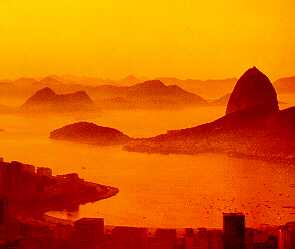
The Photographers |
| One of the national passions in Brazil is futebol (soccer). Most Americans don't think of it as a spectator sport but look at any broadcast of Brazil in international competition and you will see differently. The Brazilians,dressed in their colors, often take up a whole section of the stadium. They often bring the drums and play their music the whole time. It makes the games truly fun to watch. For those who know football, South American football is very different from European football in many ways. The pace of the game is different. Brazil has a long history of excellence in international competition, in 1994 it won its fourth World Cup title against the Italians, a rematch of the 1970 Cup in Mexico City. It has produced some of the greatest heroes of the game, the great Pele for example. |
The
Wonder of Brazil |
| Cooking | Friends | ||
| Orchids | Yosemite | California | |
| Ansel Adams | The Murals of Los Angeles | California Missions |
| A
Place in the Sun Voyage to Atlantis |
Ride the Rail, meet some new friends!
This page hosted by ![]() Get
your own Free Home Page
Get
your own Free Home Page